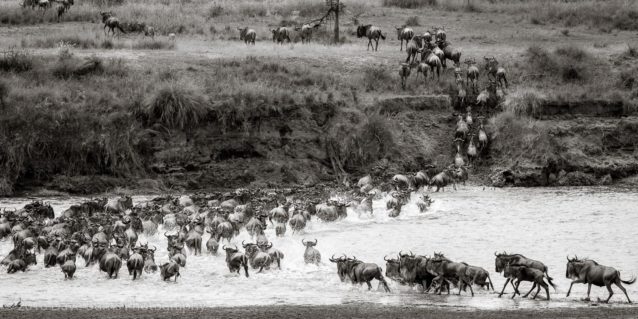
It’s a treat to wake up at a true mobile, tented camp in the middle of the Serengeti. We spent three nights here and I think it’s the most authentic way to experience a traditional safari.
On our first day, we took breakfast with us so we could drive to the river early. I was very encouraged by the massive herds of wildebeest that we drove by. It’s impossible to predict exactly when the herds will be in place to make the crossing so it’s a small gamble when you book your airfare. In other years, I might have missed by a couple of weeks.
We drove north to the Kogatende airstrip then east along the southern side of the Mara River, looking for herds massing near the riverbank. Watching the herds cross is a waiting game because they are unpredictable and get spooked easily. You wait some distance back from the river so the herds don’t get scared away and then, once they look like they are starting to cross, you move forward as fast as you can without spooking them (which means pretty slowly). And as much as you want to be alone while doing this, many other people in the area have the same idea so there’s a bit of jockeying for position as well.
We witnessed a herd crossing north while we were on the southern bank so we got some good shots as they climbed the other side.

The next day, we decided to try our luck along the northern side of the Mara River so we could get some shots of the crossing coming toward us. While we waited, we saw plenty of hippo in the water, elephants, and birds like fish eagles and the highest concentration of Rüppell’s Griffon Vultures that I’ve ever seen.



We were lucky and soon we saw a herd come down to the river. In the end, we had three crossings that day, all coming in our direction. One even changed course as they crossed and started coming up the bank next to us and around our vehicle.




Wildebeest are not the brightest animals. Some became stuck between rocks. Some were confused and were carried away downstream. Some turned around and not all of those made it back to the shore they came from. And one or two were taken by a croc.

At the end of the day, we headed back to camp, very satisfied and a little relieved that the timing had worked out so well. The next morning we were off to Moru Kopjes so after dinner and celebratory wine around the campfire, it was off to bed.
This is the fourth in my series of posts about my safari in July 2016. You can find all of them here:
- Starting My July Safari: Arusha, Mara River Crossings, Fuji X, and Lake Natron
- Notes from Lake Natron: Flamingos, Infrared, and Footprints
- Through Loliondo: from Lake Natron to Northern Serengeti
- Northern Serengeti: Wildebeest and Mara River Crossings
- Central Serengeti: Cats, Kopjes, Sunrises, and Infrared
- Tarangire: Wrapping up with Elephants, Zebras, and a Toast
About Dave Burns
Dave Burns is a wildlife, travel, and landscape photographer whose passions range from the beauty of the African savanna to the streets of Paris. He created Dave Burns Photo Tours to share his favorite places with other photographers, help them capture unique images, and learn more about photography and digital work flow. His next trip is an African photo safari to the Serengeti in February 2021. Dave’s images are in private collections and galleries. To contact him, use the contact page on this site.